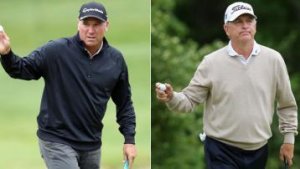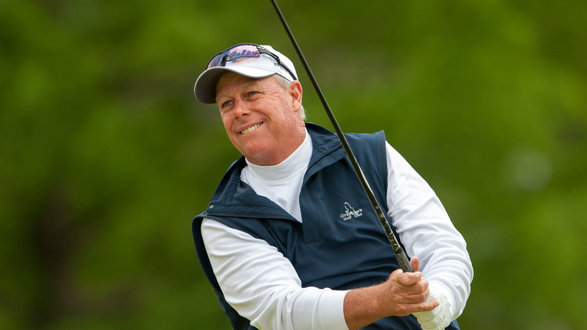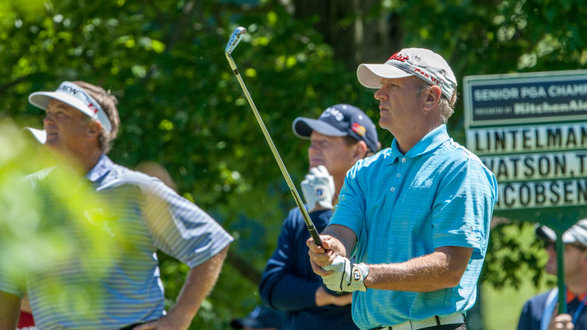Rory McIlroy Tops List of Best Golfers Under 25
Rickie Fowler and Emerging Crop of Talented Young Players Could Challenge McIlroy for Years to Come
Mark McLaughlin April 24, 2013 9:20 PM
COMMENTARY
b> | Tianlung Guan, the 14-year-old Chinese phenom, parlayed a historic Masters performance into an invite to this week's Zurich Classic of New Orleans. Guan's showing at Augusta National, where he made no worse than bogey on any hole and went the full four rounds without a three-putt, could arguably propel him near the top of rankings of the world's best young golfers.
But one tournament does not make for a reasonable assessment so I'll hold off on including Guan on my list of Best Golfers Under 25 until he at least obtains a driver's license.
Such an exercise gets tricky when you're evaluating players so early in their careers. It's a good bet that several golfers now toiling under the radar on the Web.com, European or other low profile professional tour will emerge to challenge this list of early arrivals. With that caveat, here goes.
1. Rory McIlroy
No surprise that the Ulsterman stands atop the under-25 set. McIlroy is so dominant among golfers of all ages that being on this list almost belittles his achievements. To put his early career into perspective, Rory won his second major (2012 PGA Championship) five months earlier than Tiger Woods won his second (1999 PGA Championship).
McIlroy, who turns 24 next month, has more PGA Tour wins (six) than every other player under 30 except Dustin Johnson. When you count European Tour victories, he has won 10 times since turning pro at age 18.
While Rory does not have a win since last September, that's hardly cause for panic. Sure, the equipment change to Nike hasn't exactly gone swimmingly but McIlroy has shown signs of form in recent weeks. Don't forget that a young Woods suffered through a similar slump when undergoing his first swing change, winning just once in nearly two years from 1997 to 1999.
The next few years will tell us if McIlroy can win more majors and stay on the rarefied career trajectory of Woods or if he will settle into a more normal rhythm of winning once or twice per year. I'm hoping for the former, if only to keep talk of the Tiger-Rory rivalry alive.
2. Rickie Fowler
Many of you took me to task for my column last month criticizing Fowler's poor game management and lack of wins. There's no debate that he's made a bigger impact on golf than just about anyone since turning pro. The problem is that he started on such a high note - losing a playoff in his second pro start and sinking clutch putt after clutch putt as a captain's pick at the 2010 Ryder Cup - much more was expected than one PGA Tour win in the ensuing two and a half years.
I believe the 24-year-old Fowler will start winning more as he continues to mature. He's still young and having the time of his life riding dirt bikes, hanging with "The Golf Boys" and making fashion statements every week with his pastel Puma wardrobe. I think the fun factor will prevent burnout and allow Fowler to stay in his prime longer than most pros.
Short of a victory, Fowler is having a consistently strong season. He's missed only one cut and has three top 10 finishes in eight starts. His putting is the best it's ever been. Fowler just needs to find a few more greens to let the flat stick make a difference.
3. Matteo Manassero
Manassero, who turned 20 last week, was almost an afterthought playing in the same group as Guan at the Masters. It didn't help that he missed the cut while the 14-year-old squeaked into the weekend.
The young Italian has made his own history, though, becoming the youngest-ever winner on the European Tour when he captured the 2010 Castello Masters as a 17-year-old. Manassero has added another Euro victory in each of the last two seasons and improved his chances of making it four straight years with a win by committing full-time to playing in Europe for the rest of 2013.
For Manassero to elevate his stature, however, he will need to play more here. In 17 U.S. starts since 2010, he's recorded just a single top 10 finish. But as the second youngest member of this list, he's got plenty of time to acquaint himself with the PGA Tour.
4. Russell Henley
Winning has come quickly for the 24-year-old Henley. He first won on the Web.com Tour as an amateur in 2011, added two more Web.com wins last year after turning pro and kicked off his PGA Tour career by winning in his first rookie start at the 2013 Sony Open in Hawaii.
Henley has posted two top 25 finishes since breaking through in Hawaii and is solid in all facets of the game, as shown by his top 5 ranking in the Tour's All-Around category. With his accuracy off the tee, he could be a factor at some of the tougher venues on tap including Quail Hollow, the U.S. Open at Merion and Congressional.
Henley's early success is no fluke. He was a three-time All-America and 2010 College Player of the Year at the University of Georgia as well as low amateur at the 2010 U.S. Open.
5. Jordan Spieth
Select few players have made it onto the PGA Tour without grinding through Q-School or apprenticing on the Web.com or mini-tour circuit. Spieth is poised to join Woods, Phil Mickelson and most recently Bud Cauley in playing their way to Tour membership.
Spieth, 19, has recorded three top 10 finishes in his first seven pro starts, earning enough prize money ($662,398) to gain special temporary Tour membership for the rest of 2013. This status enables him to accept an unlimited number of sponsor's exemptions into tournaments and should allow him to earn enough to gain full-time status by year's end. Spieth, who finished ninth last week at the RBC Heritage, is in this week's field in New Orleans.
Spieth first made headlines by finishing tied for 16th at the HP Byron Nelson Championship as a 16-year-old. The only golfer besides Woods to win multiple U.S. Junior Amateur titles, he led the University of Texas to the 2012 national championship as a freshman before turning pro at the end of the year.
6. Ryo Ishikawa
Ishikawa has built his reputation on tremendous success in his native Japan. The 21-year-old has 12 professional wins on the Japanese Tour, including a maiden victory while only 15.
He has yet to make his mark in the U.S. but it's not for lack of trying. Ishikawa played a full PGA Tour schedule in 2012 -- earning a second place in Puerto Rico and four top 25s -- and plans to do the same this year. He's missed the cut in half of the 54 Tour appearances since 2009 so consistency is an issue that will need to be addressed.
Ishikawa has struggled in 2013 as a typically strong putter has failed to cooperate. On the bright side, he was in contention at last week's RBC Heritage before closing with a wind-blown final round 80.
Mark McLaughlin has reported on the PGA Tour for the New York Post, FoxSports.com, Greensboro News & Record, and Burlington (N.C.) Times-News. He is a past member of the Metropolitan Golf Writers Association. Follow him onTwitter @markmacduke.







